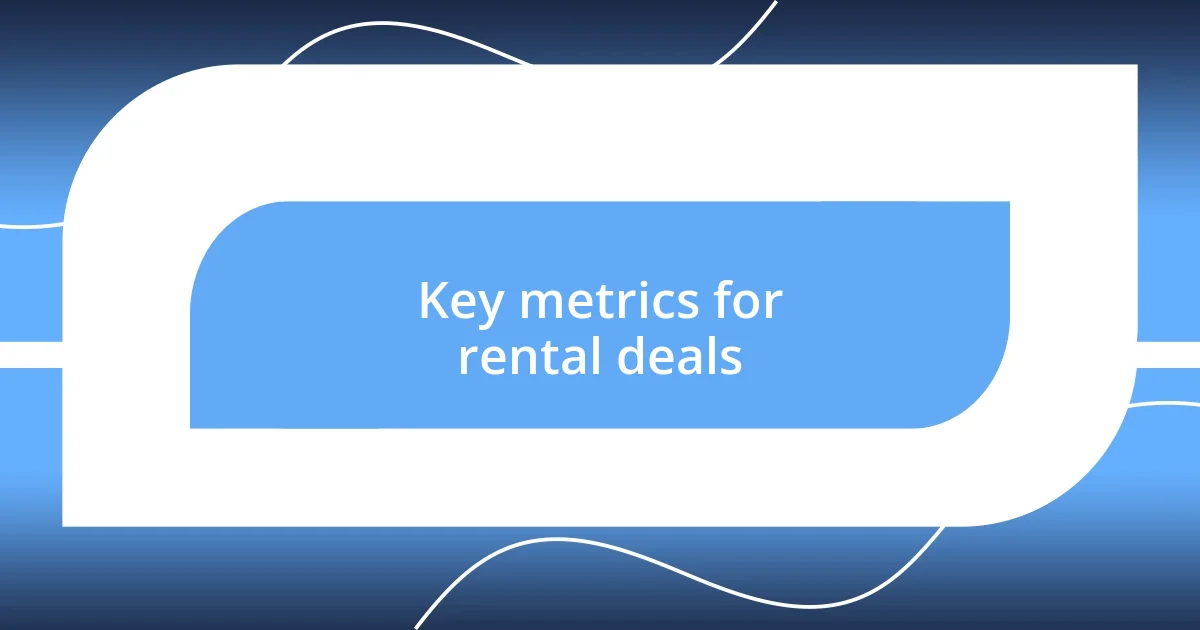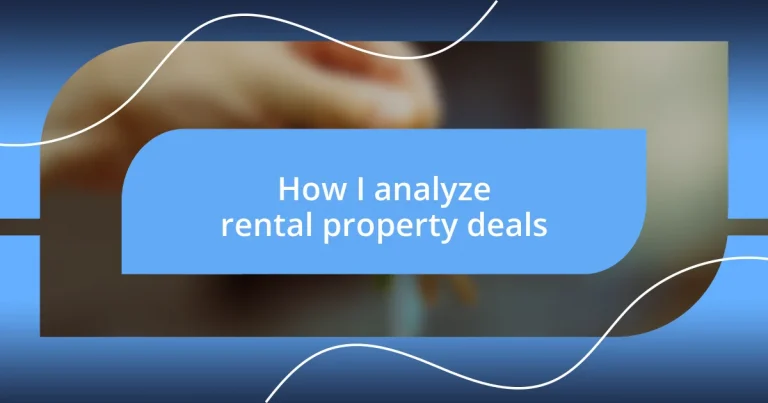Key takeaways:
- Understanding both cash flow and long-term appreciation is critical for making sound rental property investment decisions.
- Key metrics such as cap rate, gross rent multiplier, and occupancy rate are essential for evaluating a property’s potential profitability.
- Trusting your instincts, engaging with the local community, and having clear investment criteria can significantly influence the final decision-making process.

Understanding rental property analysis
Understanding rental property analysis is more than just crunching numbers; it’s about envisioning the future of your investment. I remember my first rental property deal—before diving into the spreadsheets, I spent hours walking the neighborhood, feeling the pulse of the community. It struck me then just how important location and local amenities are to potential renters. Wouldn’t you agree that the vibe of an area can drastically affect its rental appeal?
When I analyze a deal, I always start by looking at the cash flow. The simple calculation of rental income minus expenses helps clarify whether the property will genuinely support my financial goals. I still recall a property I almost purchased that looked good on paper—great rental price and ROI—but after considering repairs and vacancies, it quickly became apparent that it would drain my resources rather than grow them. How do you prioritize your expenses when assessing a property?
Additionally, there’s the long-term appreciation potential to consider. I often reflect on how a property in an up-and-coming neighborhood that I chose for its low entry cost turned into a gold mine. This isn’t just about immediate cash flow; it’s about securing a lucrative asset for years to come. Have you thought about how appreciation could impact your investment strategy? Understanding these elements can truly transform your approach to rental property analysis.

Key metrics for rental deals
When I dive into rental property deals, there are several key metrics I focus on that guide my decision-making. One metric that stands out is the capitalization rate, or cap rate. This percentage reflects the property’s income relative to its purchase price, and I’ve found it invaluable for gauging a property’s potential profitability. For instance, I once passed on a property with a strong rental income but a low cap rate. Later, I discovered it had hidden maintenance issues that would have eaten into my profits considerably.
Here’s a quick list of essential metrics to consider:
- Cash Flow: Rental income minus all expenses, including mortgage, taxes, and maintenance.
- Cap Rate: Annual net operating income divided by the property purchase price, indicating potential return on investment.
- Gross Rent Multiplier (GRM): The property price divided by gross rental income, helpful for quick comparisons.
- Occupancy Rate: The percentage of time a property is rented versus vacant, which impacts overall income stability.
- Debt Service Coverage Ratio (DSCR): A measure of cash flow relative to debt obligations, giving insight into financial stability.
I think about these metrics when evaluating a property’s health. Once, I got caught up in a deal’s charm but overlooked the occupancy rate. The neighborhood had a reputation for high turnover, which ultimately raised my expenses over time. Trust me; evaluating these metrics can save you from financially draining decisions.

Calculating cash flow effectively
Calculating cash flow effectively is paramount in ensuring a sound investment. When I first started in real estate, I underestimated the importance of consistently tracking cash flow. Now, I scrutinize every detail, from rental income to maintenance costs. I vividly remember a property that appeared perfect on the surface; the rental income was attractive, but once I accounted for recurring expenses, my profit margins shrank impressively. Have you ever taken a closer look at your own expenses only to find a few surprise costs lurking in the shadows?
I prioritize my cash flow calculations by using a simple but effective formula: Total Rental Income – Total Expenses = Cash Flow. It’s essential to include all predictable expenses, like property management fees, insurance, and maintenance. I once learned this lesson the hard way when a series of unexpected repairs nearly wiped out my profits for an entire year. That experience solidified my habit of forecasting expenses as accurately as possible. What strategies do you use to anticipate potential costs in your investment properties?
To better understand how to calculate cash flow, here’s a comparison of two hypothetical scenarios. This illustrates how minor differences in expenses can lead to drastically different outcomes, emphasizing the need for precision in cash flow analysis.
| Scenario A | Scenario B | |
|---|---|---|
| Total Rental Income | $30,000 | $30,000 |
| Total Expenses | $22,000 | $25,000 |
| Cash Flow | $8,000 | $5,000 |

Evaluating property locations
When I’m evaluating property locations, I can’t help but consider the neighborhood vibe. I remember one time, I fell in love with a charming property, but the surrounding area felt a bit off. It turned out that a few blocks away, a high-crime neighborhood dulled its appeal. I think it’s vital to stroll through the area at different times of the day, feel the energy, and pay attention to things like street activity and nearby amenities—these factors shape the desirability of a rental.
Another aspect I prioritize is proximity to schools and parks. In my experience, properties near reputable schools tend to attract families, which can lead to longer tenant stays. I recall buying a unit just a few blocks from a highly rated elementary school. This strategic location not only made it easier to find tenants but also allowed me to charge a slightly higher rent due to the demand. Have you checked out school ratings before? It’s worth it!
Lastly, I can’t ignore the long-term potential of the area. Watching for signs of development or revitalization can be a game changer. I once invested in a neighborhood that had plans for a new shopping center, and that foresight rewarded me with both increased property value and rent as the area became more desirable. It’s always interesting to think about how location affects not just the present but also future investment returns. What’s your approach to predicting neighborhood trends?

Assessing potential risks
When assessing potential risks in rental property deals, I always start with the most significant one: market fluctuations. I recall purchasing a property right before a sudden downturn in the housing market. What at first seemed like a sound investment quickly became a source of anxiety as values dropped. Are you prepared for the possibility of a market dip? I’ve learned the hard way that having a contingency plan can significantly impact long-term success.
Another critical risk to consider is the tenant profile. I’ve had my share of challenging tenants, and it was a lesson in careful screening. One particular tenant left my property in disarray and significantly affected my cash flow. Now, I prioritize background checks, income verification, and even past landlord references. I often wonder, how thoroughly are you vetting potential tenants? Taking these steps not only minimizes future headaches but also sets a precedent for maintaining property value.
Lastly, I never overlook environmental risks. Hurricanes, floods, or even pest issues can threaten an investment’s viability. In one instance, I invested in a property that seemed great, but it was in a flood zone—something I only considered after it was too late. I often ask myself, how well do you assess environmental risks before diving into a deal? These assessments can save you from unfortunate surprises down the line, ensuring your investment remains secure.

Tools for property analysis
When it comes to property analysis, I rely heavily on technology to streamline my decision-making process. A few years back, I discovered a fantastic app designed for real estate investors that can crunch numbers and forecast potential returns in a matter of minutes. It felt like having a financial advisor right in my pocket! Have you tried any property analysis apps yet? They can save you a lot of time and help you focus on making well-informed decisions.
Another tool that I find immensely helpful is comparative market analysis (CMA) reports. I remember working through the numbers for an interesting duplex when I came across a CMA that highlighted similar properties in the area. It gave me a clearer view of pricing trends, which ultimately guided my offer. It’s like having a cheat sheet for the market! Have you ever used CMAs to make a smart investment decision? They’re invaluable for understanding where your property stands in the competitive landscape.
Lastly, I can’t stress enough how vital online property management platforms have become for my analysis. I once had the daunting task of tracking expenses, tenant communications, and maintenance requests across several units. Finding a centralized system not only simplified my life but also presented my data in easy-to-understand visuals. I often think about how I managed before this tool! Do you have a system in place to track your investments? The right property management software can truly enhance your overall rental experience and provide peace of mind.

Finalizing your investment decision
Once you’ve assessed the risks and gathered your data, finalizing your investment decision involves trusting your instincts. I remember a time when I hesitated over a property that checked all the boxes—great location, solid numbers, and potential for appreciation. Yet, something felt off. I listened to that nagging voice and decided to pass. How often do we ignore our gut feelings in pursuit of mere numbers? That experience taught me that intuition holds as much weight as concrete data.
Connecting with the local real estate community can also play a crucial role in making that final decision. I once attended a neighborhood association meeting for a property I was considering. Meeting residents and hearing their concerns about developments sparked invaluable insights I hadn’t considered. How often do we tap into community voices before committing to an investment? It’s remarkable how the local chatter can illuminate facets of a property that data alone may not reveal.
Ultimately, I emphasize the importance of setting clear criteria before jumping in. For me, these criteria acted like a compass guiding my decisions. I once had a property that exceeded my budget but seemed like an opportunity of a lifetime. I paused and re-evaluated my parameters, reminding myself of my long-term goals. Do you have clear guidelines to navigate your investment landscape? Aligning your choices with well-defined criteria helps ensure that you’re making decisions that resonate with your financial objectives.














